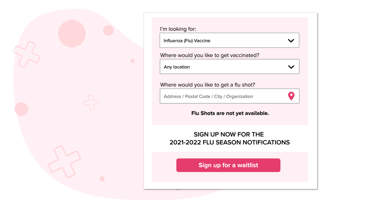Vaccine Inventory Management 2.0, Advanced Email Reminders, MyVaccines.ca Launch and More! Welcome...
Lessons Learned from the 2020-2021 Ontario-wide Pilot – iamsick.ca blog

During the peak period of Canada’s 2020-2021 flu shot distribution, demand for influenza vaccines was higher than expected. Many people were hoping to be vaccinated to avoid having symptoms and the potential for a serious enough case to be hospitalized during an expected second wave of the COVID-19 pandemic. The combined effect of higher than anticipated demand along with vaccine distribution delays resulted in many vaccination clinics being short on supply, leading to busy phone lines, long line-ups, overworked staff, and frustrated patients.
But vaccine access wasn’t evenly impacted. Some healthcare organizations had supply of influenza vaccines but very little traffic or interest from their local community, leading to a mismatch of demand and supply in many areas.
We saw behaviour similar to what happened during the COVID vaccine rollout, where people were searching for flu vaccines and in some cases going well out of their way to be vaccinated.
During 2020, we ran an Ontario wide campaign called MyFluShot.ca, in partnership with Immunize Canada, to encourage providers to provide greater transparency to real time vaccine availability inventory. We had 3,439 participating pharmacies and 1,342 participating medical clinics who signed up to provide their flu vaccine availability and inventory data. That data was presented to patients on our health services locator, specifically filtered to show locations offering flu shots.
Over that time we had over 3 million searches for flu vaccines on our platform. A post user survey of 1277 users found that 92% had found a flu vaccine through MyFluShot.ca. 47% had used the waitlist / notification feature, a unique ability we built into the platform for users to be added to a waitlist and be notified when a flu vaccine was available at their desired location. 84% mentioned they would use the platform again during the next Flu season. One user in particular comes to mind who was looking for a high dose flu vaccine for her and husband, and finding none in her local community found a location 80 KMs away and booked an appointment for her and her spouse. It made her feel very relieved that they were able to do this without a lot of hassle (except for a drive).
Increase Transparency
We learned during the pilot that increasing transparency reduced patient frustration when demand exceeded supply. Waitlists and email communications are vital when managing expectations of potential patients. As with any new tool, there is a learning curve for some users, and we gained some valuable feedback as to how to make the process easier for users.
From provider based to regional based waitlists.
We learned that many patients looking for vaccinations are flexible to where they receive it, and like Covid vaccinations, many patients were putting themselves on multiple locations’ waitlists. This creates an inefficiency for the whole system. To address this, we’ve built into MyVaccines a regional waitlist. A patient can sign up for a vaccination waitlist for a specific location, group of locations, or a region, and be notified when any provider has vaccinations available. We expect this to further optimize demand and supply of vaccinations in the future and make the lives of healthcare organization administrators easier as they don’t have to manually remove patients from waitlists who’ve gotten their vaccination somewhere else. It will also save the patients time as they don’t have to appointment shop at dozens of locations.
Adopt Technology Faster
Patients want an easy path to get vaccinated. The easier it is, the more likely we are to having more equitable vaccination access. Technology, or lack thereof, is a barrier. Having patients trying to call multiple healthcare providers when their time is limited, and / or have language barriers or have accessibility issues can prevent them having timely access to vaccines. With the use of technology that allows them to search, join a waitlist, and book appointments when vaccines are available makes vaccinations easier to access. Healthcare organizations have typically been slower to adopt new technologies, but are moving faster to add these services to their practice.
Changing is always more challenging in healthcare due to the higher risk involved in managing sensitive information and protecting patient health records. Yet the time is right for the adoption of these types of tools to accelerate.
.png?width=1945&height=350&name=empower_logo-h_digital%20(1).png)


